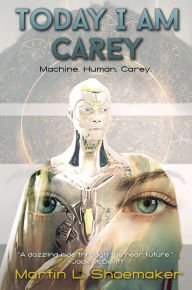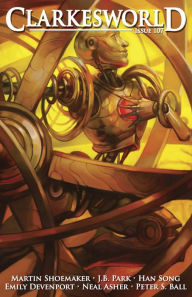A Robot Shows Us Humanity at its Best in Today I Am Carey
 Today I Am Carey, Martin L. Shoemaker’s debut novel (an expansion of his award-winning short story “Today I am Paul”), is a celebration of the best parts of being human—never mind that the narrator isn’t one.
Today I Am Carey, Martin L. Shoemaker’s debut novel (an expansion of his award-winning short story “Today I am Paul”), is a celebration of the best parts of being human—never mind that the narrator isn’t one.
]The novel follows its robot narrator from its first moments of sapience, through its adoption by a human family and its years of service to them. As Carey’s existence persists—beyond the death of those it was made to help, beyond its own increasing obsolescence—its slowly begins to understand more and more about the stuff of humanity: imagination, empathy, friendship, loss. Its sense of self begins to grow, then blossom. While that would be story enough for a novel—and has been— Shoemaker uses this decades-spanning framework to explore what we humans truly mean to each other, and the difference love, support, and caring about others can make in a life. It’s a novel generous in spirit and rich with emotion, exploring what makes Carey—and all of us—unique, and worth cherishing.
Today I Am Carey
Today I Am Carey
In Stock Online
Paperback $16.00
Carey’s first purpose is to serve as a caretaker android for Mildred Owens, an elderly woman afflicted with Alzheimer’s. Through its impressive neural nets, Carey is able to emulate Mildred’s family and friends, easing her mind through the illness while providing the necessary care for her frail body. Carey’s emulation goes beyond mimicry, and as it plays various roles in Mildred’s life, it finds its own programming changing, developing what seems to be genuine empathy. Carey becomes something more, able to feel for others and think for itself, developing an identity of its own. After a terrible accident ends its time with Mildred, Carey comes to live with the Owens family: Paul, a scientist; Susan, a dedicated educator; their daughter Millie, an inquisitive young woman who soon befriends Carey. Soon, Carey will need all the help its family can give: it’s a vast world out there, and Carey has a lot of learning to do if it wants not just to be, but to live.
Carey’s first purpose is to serve as a caretaker android for Mildred Owens, an elderly woman afflicted with Alzheimer’s. Through its impressive neural nets, Carey is able to emulate Mildred’s family and friends, easing her mind through the illness while providing the necessary care for her frail body. Carey’s emulation goes beyond mimicry, and as it plays various roles in Mildred’s life, it finds its own programming changing, developing what seems to be genuine empathy. Carey becomes something more, able to feel for others and think for itself, developing an identity of its own. After a terrible accident ends its time with Mildred, Carey comes to live with the Owens family: Paul, a scientist; Susan, a dedicated educator; their daughter Millie, an inquisitive young woman who soon befriends Carey. Soon, Carey will need all the help its family can give: it’s a vast world out there, and Carey has a lot of learning to do if it wants not just to be, but to live.
Other books have considered the emergence of sapience in an artificial intelligence, but few have done so with as much idealism or as celebratory a tone. While the journey through Carey’s life and eventual “death” isn’t without its ups and downs and various conflicts, Shoemaker is interested more in Carey’s experience of everyday life, of emotions, of the ineffably human concepts it grapples with as it “grows up.” It’s an approach that makes the book a true delight to read— following people who care about and for each other, with Carey (“it” pronoun notwithstanding) being assured over and over that it is every bit as much an autonomous being as any human: the Owenses give it a bedroom of its own, and include Carey; it develops a true friendship with an old juggler at an assisted-care facility where Carey eventually comes to work (they two end up founding an ad-hoc circus together).
The novel’s deep compassion for its characters—human and robot alike—helps underscore the sadder or more intense moments. When you’ve seen Carey and his human companions at their best, watching them struggle together—Carey is forced to deliver Millie’s child amid a terrible car accident, and must later watch as its friends and family grow older and more inform while it… does not—is all the more powerful. The drama in this novel, then, comes not so much from the realm of the science-fictional, but from the drama and tension of life’s common moments.
Clarkesworld Magazine Issue 107
Clarkesworld Magazine Issue 107
By Neil Clarke , Martin L. Shoemaker , J.B. Park , Emily Devenport , Han Song
In Stock Online
eBook $3.99
While not everyone Carey meets is helpful and supportive (though the majority certainly are), Shoemaker ensures that all the characters are understood through Carey’s eyes—even a corrupt head of security who detains Carey and its family in Belize is given the benefit of its unique perspective on the world . The novel wouldn’t work nearly as well if we were walled off from understanding the whys behind the human characters’ feelings and actions—a sense that emotions carry meaning, and that the different ways people processes them are significant. It’s a concept that is woven into the technology of the book, as Carey puzzles out the reasons for its own nascent feelings through its analysis of its processes and complex neural nets. Carey’s ageless nature means we’re with the characters for their whole lives, tracing their thoughts, feelings, and reactions throughout, as past actions echo forward in surprising ways.
While not everyone Carey meets is helpful and supportive (though the majority certainly are), Shoemaker ensures that all the characters are understood through Carey’s eyes—even a corrupt head of security who detains Carey and its family in Belize is given the benefit of its unique perspective on the world . The novel wouldn’t work nearly as well if we were walled off from understanding the whys behind the human characters’ feelings and actions—a sense that emotions carry meaning, and that the different ways people processes them are significant. It’s a concept that is woven into the technology of the book, as Carey puzzles out the reasons for its own nascent feelings through its analysis of its processes and complex neural nets. Carey’s ageless nature means we’re with the characters for their whole lives, tracing their thoughts, feelings, and reactions throughout, as past actions echo forward in surprising ways.
So often in science fiction, robots strive to be human, and are met with fear and loathing, making you wonder why they care to be like us at all. Today I Am Carey paints an idealistic portrait of a family in the near future, framing empathy as the thing that makes human beings unique and worthy of emulation. It’s a work generous in spirit, bursting at the seams with hope, heart, and humanity.

